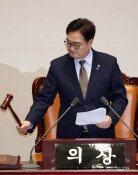Real estate regulations lifted across Seoul capital area
Real estate regulations lifted across Seoul capital area
Posted January. 04, 2023 07:51,
Updated January. 04, 2023 07:51
The current real estate regulations will soon be lifted across the country with the few exceptions of the three Gangnam areas and Yongsan in Seoul. The latest wholesale deregulatory step will be applied to the four regions in Seoul and Gyeonggi Province, previously designated as the adjustment targeted areas, overheated speculation zones, and speculation areas. This will facilitate the selling and buying of houses by significantly easing the regulations on taxes, loans, applications, and the prohibition of resale. The ceiling system on housing prices will also be lifted altogether except for a few speculation areas, including the three Gangnam regions.
The latest step aims to tackle the severe doldrums of the real estate market characterized by a drastic absence of trade, plummeting home prices, and a swell in unsold apartments, ultimately preventing them from morphing into a financial crisis with potential consequences to destabilize the country’s real economy. While the Yoon Suk Yeol administration came up with deregulatory measures over three times last year, it did not touch the metropolitan areas, considering it an untimely step. The sudden shift of stance from the government in merely two months reflects the severe potential damage that the crunch in the housing market might cause to the country’s economy.
Demand for buying has long been missing owing to the double whammies of frozen domestic demand and inflation spike. The apartment prices in Seoul are making their steepest dip for eight consecutive weeks, and the trade volume remains around one-tenth of the usual. Notably, a huge chunk of property project financing (PF) is rapidly becoming distressed owing to a surge of unsold houses. A sense of peril is growing ever more palpable that this might lead to a PF-triggered financial crisis, given the mounting loans worth a whopping 110 trillion won from secondary financial sectors, including insurance, securities, and savings banks.
Of course, the latest step should not be erroneously construed by some speculators as an encouragement to wait out. A turnaround in market sentiment in the latter half of the year, which slowing interest hikes will likely mark, could trigger yet another bout of price spikes, which must be addressed in advance. While the government hinted at making additional steps down the road, it needs to make a more careful approach; it must refrain from touching the three Gangnam regions in particular, as they could fuel an explosive rise in housing prices again. Some of the crucial financial regulations, such as the debt service ratio (DSR), must be kept in place to prevent swelling loans eroding household debts, as was the case for the younger home buyers in their 20s and 30s, who were caught in a “debt trap” last year.
But many experts are still skeptical that the latest step should be effective in stopping the plunge of housing prices, given the pronounced momentum for interest hikes. A spurry of stimulus measures, whose effect has yet to kick off, might translate into a severe backlash once the market is normalized. A more patient approach is needed where the authorities can thoroughly monitor price anomalies deriving from deregulation and fix the problems. The government must signal to the market that it intends to protect actual demand while throwing the book at speculators.







